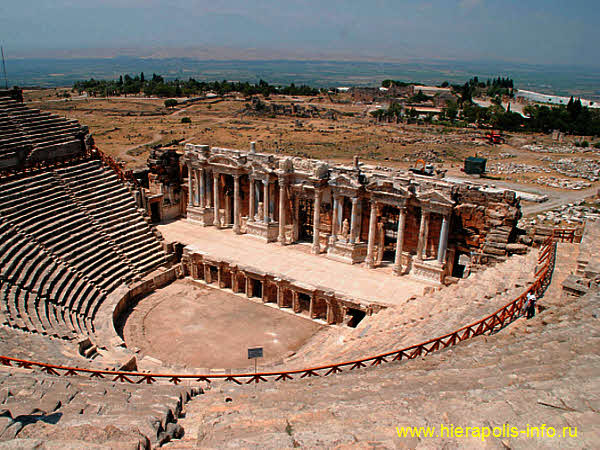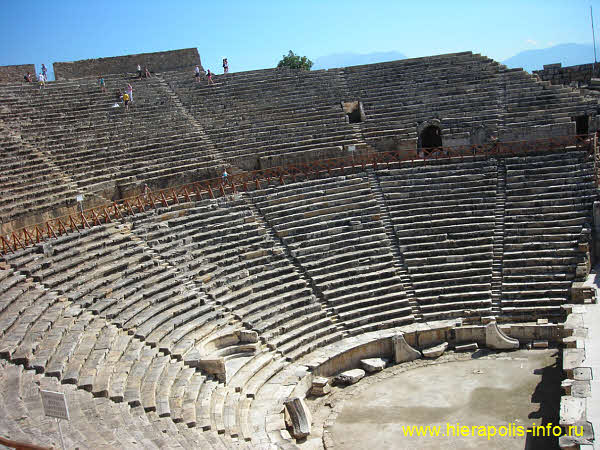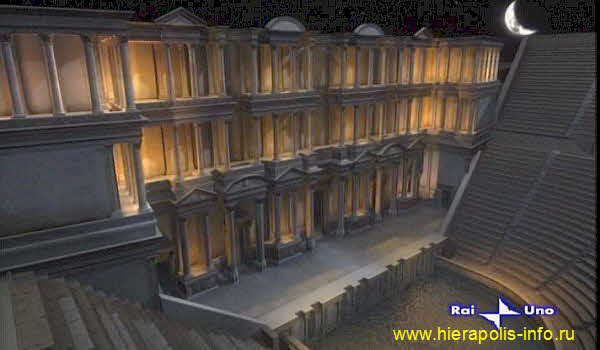The Hierapolis Theatre
Tourists arriving on a trip to Pamukkale (Turkey) inadvertently affects the grandeur of the Greco-Roman theater, suddenly
appearing among the ruins and debris of ancient Hierapolis, randomly covering snowy mountainside.
Selling to you the tour to Pamukkale, tourism manager casually mention that next to the slope, you can see
minor and uninteresting artifacts of the ancient city Hierapolis. For example, a relatively large necropolis

or the walls of the former city of Hierapolis, heavily damaged in the 7th century BC. However, curious
sightseers can detect not only the historical museum, but also a lot of artifacts, from which literally
mesmerizing spirit. It is not only the
crypt of the Basilica of St. Philip
or pagan Plutonium. Mainly
it is the
Greco-Roman theater Hierapolis, partially saved by time and slowly being restored, since 1957,
(thanks to
the mission MAIER).
Having been on the upper rows of the hall, feeling the incredible grandeur of Roman architecture and
the care with which restored its architectural elements and the first of all - floor of the stage,
visitors
Pamukkale suddenly realize that here the beautiful views of the valley of the Meander
admired by our ancestors who built here unique Hierapolis city, unfortunately died of earthquakes,
barbarism robbers Persians and the Seljuks and then ruthlessly buried under the sand, however, has left us
a lot of reasons for the curious discoveries and even a sensation.
Brief architectural and historical background
|
|
The theater was built on a small hill, which is a
natural foundation for the all complex construction. In addition, an important factor was the proximity of
the sanctuary of Apollo - god, whom often held games and performances in the Greco-Roman theater Hierapolis.
It is expected that between these structures were often held solemn processions.
At the stage the architectural design the theater was harmoniously into the surrounding city landscape
and occupied four standard city blocks of Hierapolis.
|
After the ritual and magical representations in the temple of Apollo and the underground plutonium people crowd
moved further into the ancient theater of Hierapolis. Perhaps only some distance from the main street (Frontinus)
have a slight dissonance, but it was impossible "to move the hill", and therefore with the location of the
new, the Roman theater Hierapolis had to simply accept.
Auditorium
The auditorium of the
theater of Hierapolis included forty-five rows of seats. It is divided by diazomata
into two halves: upper (summa cavea)- 25 series and lower (ima cavea) - 20 series of seat. In addition,
the audience is further divided by 8 vertical passages (scalaria) into nine sectors (cuneus). Estimates
Palolo Verzone (first head of mission MAIER), Hierapolis theater could accommodate 12,000 spectators.
In the future, in different studies, this figure varies greatly, even reaching a fantastically unacceptable
- 25,000 spectators. Special public passageways on the upper floors of the auditorium provides by arched
brick tunnels, laid under of seats(aditus). Semicircular seat, rather bed (pulvinar tribunalia) was located

at the bottom of the auditorium. Tribunalia has been reserved for the privileged guests of Hierapolis,
and of course, the emperors of Rome. A number of rectangular recesses, made in the benches near the podium,
indicating the use of a light canopy (baldachin), probably from the sun's rays.
The first rows of the auditorium near the bleachers filled for rich or honorable citizens. Hierapolis
Theatre Orchestra is horseshoe-shaped and framed by high walls. The radius of the orchestras is 25 meters
and the auditorium (cavea) 100 meters.
Two types of building materials have been used in the construction of the roman theater in Hierapolis (Asia Minor, Turkey):
limestone for architectural details and marble for decoration. Seats ima cavea and summa cavea first
series were made of marble. The upper rows of seats summa cavea made of travertine, transferred
from the old greco theater and mounted on an artificial structure since gone beyond the natural
slope of the mountain. Inside the substructure were formed arched passageways, which facilitated
the entry-exit of spectators at performances.
The historical aspect
The ancient theater was build in Hierapolis (Asia Minor, Phrygia) in 1-3 centuries BC.
Theater was created after the devastating earthquake of 60 AD, which caused severe damage to the city,
including the auditorium the old Greek theater, which was built in the Hellenistic period on a high
hill in the north part of Hierapolis city.
Through artifacts founded during the reconstruction of the lower ranks of the auditorium stage and the
simple facade of the theater scene in Hierapolis exact dates from the reign of Emperor Domitian (81-96 AD).
In the second phase of theater construction was built upper seat auditorium (summa cavea) and
improved passages in the Hierapolis Roman theater. These works are dated back to the reign of the
Emperor Hadrian (in the first half of the second century AD), who visited Hierapolis at 129 AD.

However, the most important building of the theater Hierapolis (now Pamukkale, Turkey) were carried out
during the reign of Emperor Septimius Severus (193-212 AD) and a memorable inscriptions was found
on one of arhitavrov scene. We can be accurately positioned the inscriptions by the time period from 206
to 208 AD. Only three years is need for built a delightful three-storey scene wiich is decorated with
bas-reliefs and many statues.
Two inscriptions, addressed to the Emperor Constantine, give reason to assume about the recovery work
at the end of the 4th century AD.
During this period, the stage of the theater Hierapolis was severely damaged, but some restoration work
allowed to make the previous form. In addition, during this period was performed work on the reconstruction
of bands with a view to filling it with water. Orchestra could quickly turn into a water basin (kolymbethra)
for setting, for example, sea battles. During the transformation process it was removed marble
doorways between hyposcaenium and orchestra. The void were laid with bricks. The walls and floor of the
theater orchestra of Hierapolis were treated with concrete solutions, tightly clasped together materials
for waterproofing.
Of course, it was laid inlet and outlet water clay pipes. MAIER expedition was found a numerous fragments
in the middle of the corridor hyposcaenium. Restoration of the Hierapolis theater scene is constantly held
during the 4-6 centuries. But it was stopped in the 7th century. Theatre scene was collapsed completely,
hiding under a mountain of debris statues and bareliefs.
Aspect of the restoration
For those, who prefer to study Hierapolis on articles in Wikipedia, it would be useful to know
that the roman theater in Hierapolis almost completely restored, being destroyed by earthquakes
and covered with sand at 6 series auditorium.
Theatre in Hierapolis (Turkey) was literally raised from the ruins, and the first floor of the
stage with high costs was restored MAIER mission in 1960-2014, respectively.
 or the walls of the former city of Hierapolis, heavily damaged in the 7th century BC. However, curious
sightseers can detect not only the historical museum, but also a lot of artifacts, from which literally
mesmerizing spirit. It is not only the
crypt of the Basilica of St. Philip
or pagan Plutonium. Mainly
it is the Greco-Roman theater Hierapolis, partially saved by time and slowly being restored, since 1957,
(thanks to the mission MAIER).
Having been on the upper rows of the hall, feeling the incredible grandeur of Roman architecture and
the care with which restored its architectural elements and the first of all - floor of the stage,
visitors Pamukkale suddenly realize that here the beautiful views of the valley of the Meander
admired by our ancestors who built here unique Hierapolis city, unfortunately died of earthquakes,
barbarism robbers Persians and the Seljuks and then ruthlessly buried under the sand, however, has left us
a lot of reasons for the curious discoveries and even a sensation.
or the walls of the former city of Hierapolis, heavily damaged in the 7th century BC. However, curious
sightseers can detect not only the historical museum, but also a lot of artifacts, from which literally
mesmerizing spirit. It is not only the
crypt of the Basilica of St. Philip
or pagan Plutonium. Mainly
it is the Greco-Roman theater Hierapolis, partially saved by time and slowly being restored, since 1957,
(thanks to the mission MAIER).
Having been on the upper rows of the hall, feeling the incredible grandeur of Roman architecture and
the care with which restored its architectural elements and the first of all - floor of the stage,
visitors Pamukkale suddenly realize that here the beautiful views of the valley of the Meander
admired by our ancestors who built here unique Hierapolis city, unfortunately died of earthquakes,
barbarism robbers Persians and the Seljuks and then ruthlessly buried under the sand, however, has left us
a lot of reasons for the curious discoveries and even a sensation.
 at the bottom of the auditorium. Tribunalia has been reserved for the privileged guests of Hierapolis,
and of course, the emperors of Rome. A number of rectangular recesses, made in the benches near the podium,
indicating the use of a light canopy (baldachin), probably from the sun's rays.
The first rows of the auditorium near the bleachers filled for rich or honorable citizens. Hierapolis
Theatre Orchestra is horseshoe-shaped and framed by high walls. The radius of the orchestras is 25 meters
and the auditorium (cavea) 100 meters.
Two types of building materials have been used in the construction of the roman theater in Hierapolis (Asia Minor, Turkey):
limestone for architectural details and marble for decoration. Seats ima cavea and summa cavea first
series were made of marble. The upper rows of seats summa cavea made of travertine, transferred
from the old greco theater and mounted on an artificial structure since gone beyond the natural
slope of the mountain. Inside the substructure were formed arched passageways, which facilitated
the entry-exit of spectators at performances.
at the bottom of the auditorium. Tribunalia has been reserved for the privileged guests of Hierapolis,
and of course, the emperors of Rome. A number of rectangular recesses, made in the benches near the podium,
indicating the use of a light canopy (baldachin), probably from the sun's rays.
The first rows of the auditorium near the bleachers filled for rich or honorable citizens. Hierapolis
Theatre Orchestra is horseshoe-shaped and framed by high walls. The radius of the orchestras is 25 meters
and the auditorium (cavea) 100 meters.
Two types of building materials have been used in the construction of the roman theater in Hierapolis (Asia Minor, Turkey):
limestone for architectural details and marble for decoration. Seats ima cavea and summa cavea first
series were made of marble. The upper rows of seats summa cavea made of travertine, transferred
from the old greco theater and mounted on an artificial structure since gone beyond the natural
slope of the mountain. Inside the substructure were formed arched passageways, which facilitated
the entry-exit of spectators at performances.
 However, the most important building of the theater Hierapolis (now Pamukkale, Turkey) were carried out
during the reign of Emperor Septimius Severus (193-212 AD) and a memorable inscriptions was found
on one of arhitavrov scene. We can be accurately positioned the inscriptions by the time period from 206
to 208 AD. Only three years is need for built a delightful three-storey scene wiich is decorated with
bas-reliefs and many statues.
Two inscriptions, addressed to the Emperor Constantine, give reason to assume about the recovery work
at the end of the 4th century AD.
During this period, the stage of the theater Hierapolis was severely damaged, but some restoration work
allowed to make the previous form. In addition, during this period was performed work on the reconstruction
of bands with a view to filling it with water. Orchestra could quickly turn into a water basin (kolymbethra)
for setting, for example, sea battles. During the transformation process it was removed marble
doorways between hyposcaenium and orchestra. The void were laid with bricks. The walls and floor of the
theater orchestra of Hierapolis were treated with concrete solutions, tightly clasped together materials
for waterproofing.
Of course, it was laid inlet and outlet water clay pipes. MAIER expedition was found a numerous fragments
in the middle of the corridor hyposcaenium. Restoration of the Hierapolis theater scene is constantly held
during the 4-6 centuries. But it was stopped in the 7th century. Theatre scene was collapsed completely,
hiding under a mountain of debris statues and bareliefs.
However, the most important building of the theater Hierapolis (now Pamukkale, Turkey) were carried out
during the reign of Emperor Septimius Severus (193-212 AD) and a memorable inscriptions was found
on one of arhitavrov scene. We can be accurately positioned the inscriptions by the time period from 206
to 208 AD. Only three years is need for built a delightful three-storey scene wiich is decorated with
bas-reliefs and many statues.
Two inscriptions, addressed to the Emperor Constantine, give reason to assume about the recovery work
at the end of the 4th century AD.
During this period, the stage of the theater Hierapolis was severely damaged, but some restoration work
allowed to make the previous form. In addition, during this period was performed work on the reconstruction
of bands with a view to filling it with water. Orchestra could quickly turn into a water basin (kolymbethra)
for setting, for example, sea battles. During the transformation process it was removed marble
doorways between hyposcaenium and orchestra. The void were laid with bricks. The walls and floor of the
theater orchestra of Hierapolis were treated with concrete solutions, tightly clasped together materials
for waterproofing.
Of course, it was laid inlet and outlet water clay pipes. MAIER expedition was found a numerous fragments
in the middle of the corridor hyposcaenium. Restoration of the Hierapolis theater scene is constantly held
during the 4-6 centuries. But it was stopped in the 7th century. Theatre scene was collapsed completely,
hiding under a mountain of debris statues and bareliefs.